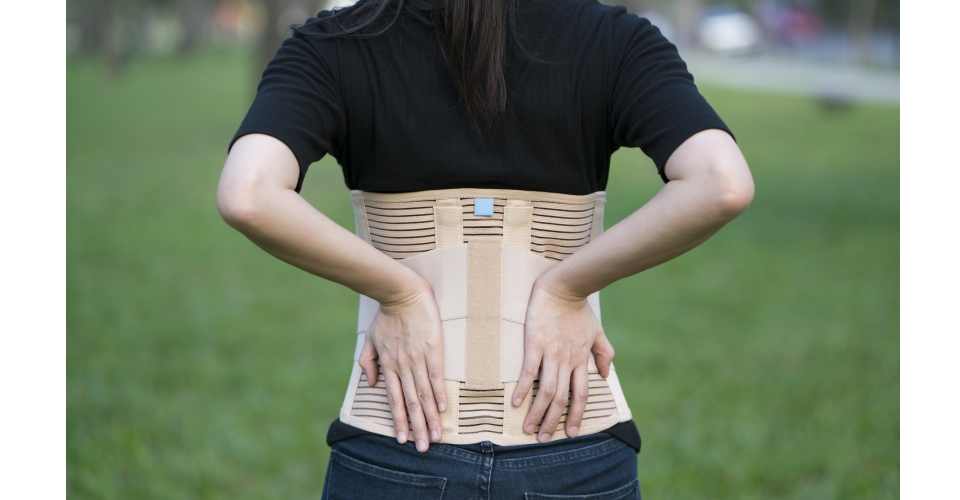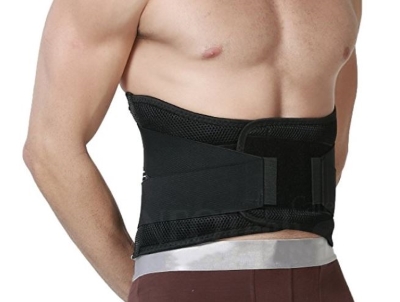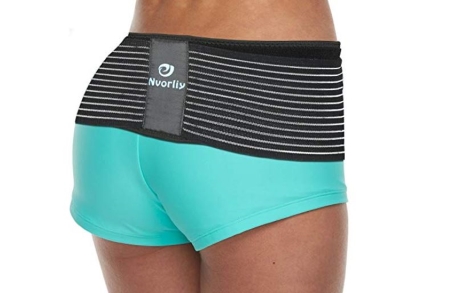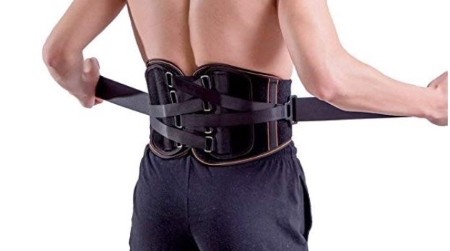
Our Editors independently research, test, and rate what we feel are the best products. We use affiliate links and may receive a small commission on purchases.
Lower back pain is a serious issue affecting more and more people each day. In fact, it’s estimated that up to 80% of the population will deal with back pain at some point in their lives. Whether it be due to a sedentary lifestyle or overworking the area, it’s not only painful, but potentially debilitating.
However, there are options; one of the best being lower back braces. Lower back braces can help with a variety of back pain conditions, and get you back to living the life you want. There are quite a few to choose from out there, so it’s important to read up on which is best for you. Also see: Top 5 Best Back Braces and Support Belts.
Why and when are back braces necessary?
The lower back is particularly vulnerable to injury due to just about every type of movement using this area. Even when we’re sitting, we use this part of the body to support us. In fact, the most common causes for lower back pain are: injury/trauma, overuse/excess stress, poor posture, pregnancy, or conditions like arthritis.
Braces are not only for those who are injured, although they can help stabilize injured areas and control pain associated with it by restricting movement. They can immobilize your spine during the healing process as well, and even prevent some injuries and pain.
Braces can range from larger sizes which go from the mid-hip to just under the shoulders, to smaller ones which just place focus on the area in question.
A doctor’s prescription will lead you to using the best back brace for you, but it’s not necessarily required. They’ll probably tell you to use the brace in conjunction with a medication or therapy. It’s important to remember that the proper treatment for your back pain is generally going to depend on the root of the issue.
If you’re experiencing extreme back pain for more than 5 days, you should immediately speak with your physician as it could be an indicator of issues that must be treated right away.
Types of Braces
There are two main types of back braces for lower back pain: flexible and rigid. Within those, are various sub-types which we’re going to cover below.
Flexible
Flexible braces are as the name suggests: made of flexible, soft material. Materials are typically one or a combination of cotton, elastic, canvas, and/or neoprene. The brace types made of these materials are corsets, lumbar belts, and sacroiliac belts. They fasten with Velcro, yet remain incredibly sturdy.

Flexible lumbar belts and corsets come in various sizes and designs. A corset model is what you’d probably expect it to look like, and is very similar to a woman’s corset.
It provides structure and support while allowing a bit of give for comfort and movement. You’ll typically find metal or plastic stays at the front, rear, and even sides of the brace, which are what provides that support.
Lumbar / Sacroiliac
Lumbar belts and sacroiliac belts restrict movement a bit more, thanks to the stronger fabric. However, these models do not include the stays the corset designs do.How do the soft designs help relieve pain and possibly help with injury recovery?

• By providing a bit of pressure to your midsection, assisting in achieving proper posture and to move weight and pressure off of the spine.
• Helping to achieve proper spinal column alignment and support
• Limiting range of motion (within reason), while still letting you move a bit.
• Lowering the amount of micro-motion in a loose or weakened joint by compressing the torso or pelvis.
• Relaxing tight muscles through warmth the brace provides.
While we always recommend consulting first with your physician, if you lead an active lifestyle and don’t need to keep the spine in place constantly, this is a great option.
Rigid / Semi-Rigid
Rigid braces are much more sturdy than the soft options. They’re made up of a stronger layer of material – generally cotton or canvas. This works by wrapping around the midsection, with the front and back pieces fastening together.
What really gives it its structure are the rigid panels which cover the front, rear, and occasionally the sides of the brace. There are unique models which will even have sturdy plastic or metal bars on the exterior.

In addition, you’ll often need to be fitted for this type. A plaster cast will be made of your torso to do this in order to fit your body precisely to get the best results.
There are also braces which are right in-between the two types, which we call “semi-rigid braces”. The reason why, is because these feature elements from both flexible and rigid models. One may have extra padding or inserts to provide an additional layer of support but are still relatively soft.
These models work by:
• Applying pressure to the midsection, keeping the spine in proper alignment while shifting weight from the spine to the abdomen.
• Giving adequate support to the midsection, relieving weakened or injured areas of the spine by taking pressure off.
• Minimizing the range of motion, eliminating the ability to move the torso forward, backward, and side-to-side. Rotation is also very limited.
• Lowering micro-motion at a spinal segment or place of injury, simultaneously aiding in the recovery of the affected area and adding protection.
• Reducing muscle tension by the warmth the brace provides.
As you can see, all versions provide quite similar benefits, with a few exceptions.
Back Brace Components
Many models will have similar parts, including rigid panels on the exterior (excluding soft braces), adjustment tabs, wings, and an adjustment cord. Rigid and semi-rigid braces are going to have a solid back panel to keep your spine in the perfect position.
These are typically used for post-operative recovery. The wings are on each side, and are made to wrap around and connect over the abdomen. The cord and tabs are just to make very precise, small adjustments to the brace.
For Best Results
Make sure that you’re using the proper back brace for what you aim to improve. If you’re lifting and want to avoid injury, get a back belt that is specifically designed for that. If you need to fix an injury, it’s always a good idea to listen to the instructions of a physician so you know you’re getting the best solution for your situation.
Your doctor will give you the proper instructions on how to use the brace, as well as cleaning and maintenance. If you don’t wear it correctly, not only is it going to help, but it can potentially worsen your situation.
Correct Wear
• Make sure to wrap the wings all the way on either side of the torso so it is fully secured.
• Connect the two ends, crossing them over the stomach.
• Adjust to your liking with precision, changing the tightness and pressure to fit your body perfectly.
• It is usually a good idea to have a partner help you put on the brace properly, as it’s not ideal with a painful back to be reaching around from behind and twisting.
• Wear your brace at all times, unless otherwise indicated by your physician/surgeon, or until your spine has properly healed. Remove only to sleep.
• We recommend wearing a shirt under the brace to eliminate any chance of skin irritation, such as chafing or redness. Try to select a more tight-fitting shirt, as baggy ones can actually irritate the skin even further.
• Always properly wash the skin under the brace to help keep dirt and dead skin cells away. If you don’t, they can help irritate and cause your skin to break out.
• Avoid wearing lotions or moisturizers on the skin under the brace, as this can cause irritation and even sores if you’re careful.
Controversy
While many people swear by using lower back braces to prevent or help with recovery from an injury, there are many who feel the opposite. Many claim that the use of back braces can potentially cause core muscles to atrophy, furthering the risk of injury.
However, these claims are unfounded, and if worn with the prescription of a physician, shouldn’t even be an issue. If speaking in terms of an injury, a back brace should never be used as the only method of recovery. They are meant to be used on a short-term basis, and those used to prevent injury while lifting, only while lifting.
Regardless, there are countless patients and users who have experienced a greater quality of life while using a back brace. They allow the user to be more active, thanks to the support it provides them. They work well for those with excess weight, just getting into working out again.
In addition, they’ve helped those with chronic conditions such as protrusions and hernias, as well as those in early rehabilitation stages after injuries.
Summary
Avoiding back injuries can be difficult to do if you’re lifting a lot, or have a sedentary lifestyle. However, if you already have an injury, we really encourage you to looking into using one of the best braces for lower back pain.
They offer a way for you to live the active life you deserve, while managing pain and helping your back heal properly. Once again, if the back pain is severe or persists for more than 5 days, you should definitely see a pain specialist to make sure it’s not something more serious.
Notice:
HealthWellness365 is a participant in the Amazon Services LLC Associates Program, an affiliate advertising program. HealthWellness365 earns fees from products sold through qualifying purchases by linking to Amazon.com. Amazon offers a commission on products sold through their affiliate links.In March 2019 Amazon announced that Health Savings Accounts and Flexible Spending Accounts (HSA/FSA) would be accepted as new forms of payment for eligible product purchases. Using HSA/FSA funds to purchase on Amazon can be a great way to reduce taxes and reduce overall healthcare costs for items not covered under medical insurance. Users of such medical savings plans are issued a debit card by their provider, which can be added to their payment methods in their Amazon account.
Whether items sold on Amazon are deemed as eligible for HSA/FSA plans remains the responsibility of the buyer and their particular health plan provider. It’s ultimately up to the IRS and participating health plan providers to deem which medical and health products are considered eligible for the payment plans.
But the eligibility is quite broad and inclusive of thousands of products that are sold on Amazon and considered Health Savings and Flexible Spending Accounts plan-eligible. See this IRS document for more information about Health Savings and Flexible Spending Accounts: https://www.irs.gov/pub/irs-pdf/p969.pdf
